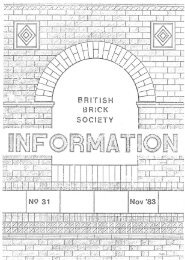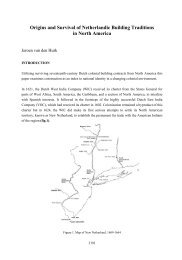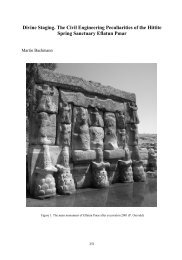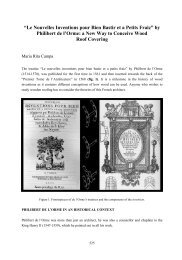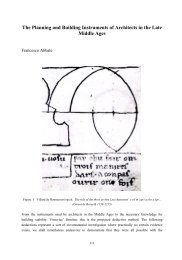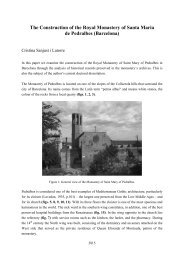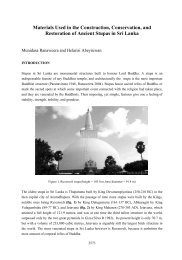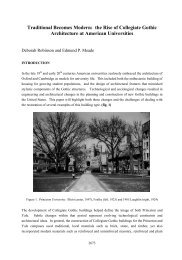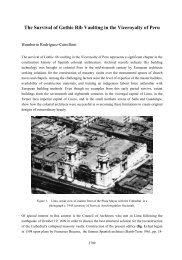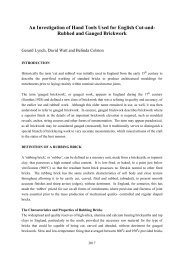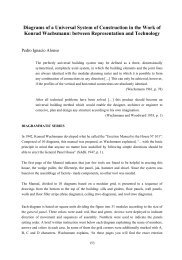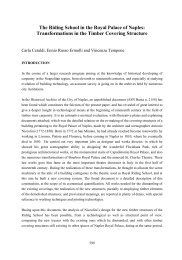Paul Bonatz and the Search for an Art - Department of Architecture
Paul Bonatz and the Search for an Art - Department of Architecture
Paul Bonatz and the Search for an Art - Department of Architecture
You also want an ePaper? Increase the reach of your titles
YUMPU automatically turns print PDFs into web optimized ePapers that Google loves.
It lasted until <strong>the</strong> rise <strong>of</strong> <strong>the</strong> Modern Movement till tectonics, called <strong>the</strong> "poetics <strong>of</strong> construction" by<br />
Kenneth Frampton (Frampton 1993, 2), took over <strong>the</strong> role <strong>of</strong> ornamentation in architecture.<br />
However, <strong>the</strong> awareness <strong>of</strong> its signific<strong>an</strong>ce somehow nearly got lost in architectural history, maybe<br />
because <strong>of</strong> <strong>the</strong> great import<strong>an</strong>ce that was given to <strong>the</strong> aspect <strong>of</strong> functionality. Never<strong>the</strong>less, authors<br />
like Julius Posener (1904-1996) finally rediscovered in Modern <strong>Architecture</strong> that “<strong>the</strong> construction,<br />
which works, is not always <strong>the</strong> construction, which one c<strong>an</strong> see." (Klotz 1986, 28). Posener realised<br />
this phenomenon through <strong>the</strong> <strong>an</strong>alysis <strong>of</strong> facades <strong>of</strong> Mies v<strong>an</strong> der Rohe’s later buildings. These<br />
buildings also stood in <strong>the</strong> focus <strong>of</strong> Eduard Sekler’s key essay about <strong>the</strong> intense relationship<br />
between "Structure, Construction, Tectonics" (Sekler 1965).<br />
Sekler saw tectonics as <strong>the</strong> visual expression <strong>of</strong> construction which itself had to be understood as a<br />
particular physical m<strong>an</strong>ifestation <strong>of</strong> <strong>the</strong> “int<strong>an</strong>gible concept” defined by <strong>the</strong> structure <strong>of</strong> <strong>an</strong> edifice<br />
(Sekler 1965, p. 92). Regarding this definition one easily c<strong>an</strong> see that tectonics should have played<br />
<strong>an</strong> import<strong>an</strong>t role especially <strong>for</strong> bridges – as structure <strong><strong>an</strong>d</strong> construction always are <strong>the</strong> two domin<strong>an</strong>t<br />
parameters <strong>for</strong> <strong>the</strong>ir design. But, nei<strong>the</strong>r Sekler mentioned engineering structures in his text nor did<br />
30 years later Kenneth Frampton, whose widely recognised book about <strong>the</strong> “Tectonic Culture” in<br />
modern time’s building brought back <strong>the</strong> idea <strong>of</strong> tectonics to <strong>the</strong> world <strong>of</strong> architectural history<br />
(Frampton 1993). Hence, in <strong>the</strong> end, both also followed <strong>the</strong> reduced path that had been laid out<br />
earlier by Sigfried Giedion.<br />
Tectonics <strong><strong>an</strong>d</strong> Construction in Engineering – a Complicated Relationship<br />
The fact that architectural <strong>the</strong>oretici<strong>an</strong>s seemed to ignore <strong>the</strong> ef<strong>for</strong>ts <strong>of</strong> architects like <strong>Paul</strong> <strong>Bonatz</strong> to<br />
tr<strong>an</strong>sfer <strong>the</strong> idea <strong>of</strong> tectonics into structural engineering finds a sort <strong>of</strong> parallel in <strong>the</strong> engineer’s<br />
view. Even if architects consulted engineers in bridge building throughout <strong>the</strong> whole twentieth<br />
century, <strong>the</strong> idealistic concept that structurally optimised edifices as bridges do not need <strong>an</strong>y<br />
tectonic treatment at all was a widespread thought.<br />
A fascinating case in this field is <strong>the</strong> comparison <strong>of</strong> <strong>the</strong> bridge over <strong>the</strong> D<strong>an</strong>ube at Leipheim on <strong>the</strong><br />
Reichsautobahn between Stuttgart <strong><strong>an</strong>d</strong> Munich (Fig.12), designed by Karl Schaechterle, Wayss &<br />
Freytag <strong><strong>an</strong>d</strong> <strong>Bonatz</strong>, with <strong>the</strong> contemporary bridge over <strong>the</strong> Arve at Vessy (Fig.13) by one <strong>of</strong> <strong>the</strong><br />
most outst<strong><strong>an</strong>d</strong>ing engineers <strong>of</strong> <strong>the</strong> twentieth century, Robert Maillart (1872-1940). The comparison<br />
<strong>of</strong> <strong>the</strong>se two bridges (both were based on Maillart’s structural concept <strong>for</strong> three-hinged arch<br />
bridges) recently was discussed by David P. Billington (Billington 1997, p. 219-20) <strong><strong>an</strong>d</strong> originates<br />
in <strong>an</strong> essay that Maillart himself published in 1938 (Maillart 1938).<br />
But, while Maillart’s biographer Billington mainly came to <strong>the</strong> conclusion that <strong>the</strong> bridge over <strong>the</strong><br />
D<strong>an</strong>ube stood symptomatic <strong>for</strong> a Germ<strong>an</strong> tendency towards a massive appear<strong>an</strong>ce, Maillart himself<br />
stressed to have worked with a different approach th<strong>an</strong> did Schaechterle <strong><strong>an</strong>d</strong> <strong>Bonatz</strong> (ibid., p. 292).<br />
In fact, <strong>the</strong> difference between <strong>an</strong> economically optimised bridge in a side valley <strong>of</strong> <strong>the</strong> mountains<br />
2152



